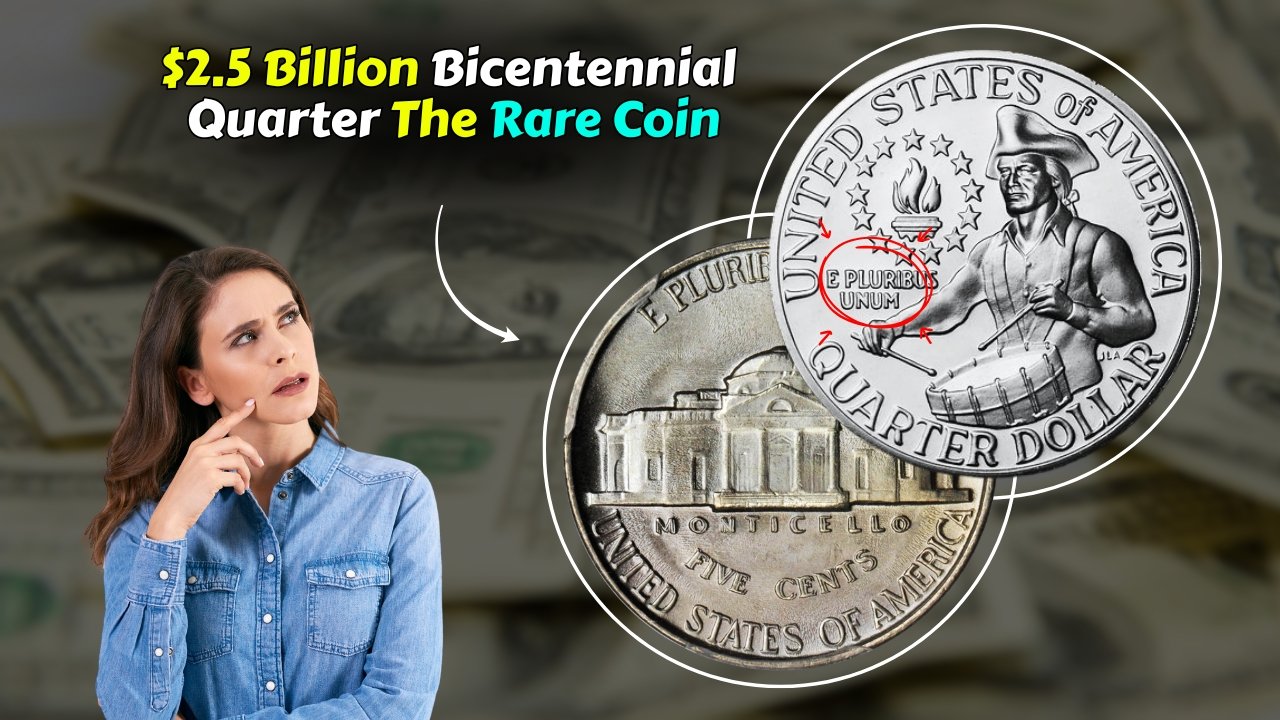Join on WhatsApp
Get the latest updates directly on WhatsApp – motivation, news & more!
Coins are often overlooked in daily life, yet some can hold incredible value. Among them, the Bicentennial quarter stands out as a piece of U.S. history with the potential to be worth a fortune. While most Bicentennial quarters from 1976 are worth only 25 cents, a rare variety has captured the attention of collectors and historians alike, with estimates reaching an astonishing $2.5 billion. This article explores why this coin is so valuable, its history, and how you might identify it in your own collection.
The History of the Bicentennial Quarter
In 1976, the United States celebrated its 200th anniversary with special commemorative coins. The quarter received a unique reverse design featuring a colonial drummer surrounded by thirteen stars, symbolizing the original colonies. The obverse retained George Washington’s familiar portrait but included the dual date “1776–1976.” Millions of these quarters were minted and released into circulation, making them one of the most recognizable coins in U.S. numismatics.
The Bicentennial quarter was intended to celebrate the nation’s history and unity, but it also became an opportunity for the U.S. Mint to experiment with design and production techniques. While most coins entered everyday use, a handful of rare versions escaped into private hands, creating enormous interest among collectors.
Why One Bicentennial Quarter Could Be Worth $2.5 Billion
The extraordinary value attributed to this rare Bicentennial quarter stems from a combination of factors: minting errors, rarity, and perfect condition. Experts believe that one coin may have been struck on the wrong metal planchet, possibly an experimental alloy intended for another coin type. Such errors are extremely rare and highly prized in the numismatic community.
In addition to the unusual composition, the coin’s condition significantly impacts its value. A coin that is free from scratches, wear, and discoloration—graded at the highest levels by professional services such as PCGS or NGC—can command an incredible premium. Collectors are willing to pay extraordinary amounts for coins that are not only rare but also preserved perfectly.
Other Valuable Bicentennial Quarter Varieties
While the $2.5 billion coin is exceptionally rare, other Bicentennial quarters from 1976 also hold significant value:
Silver Bicentennial Quarters
The U.S. Mint released limited silver-clad Bicentennial quarters as collector items. These coins were sold in special sets and were never intended for regular circulation. Today, depending on condition and silver content, these coins can fetch anywhere from $10 to several hundred dollars.
Proof Bicentennial Quarters
Proof versions of the Bicentennial quarter were struck with polished dies, creating a mirror-like finish. High-grade proof coins, especially those with cameo contrast, are highly desirable and can sell for hundreds of dollars at auction.
Error Bicentennial Quarters
Coins with misstrikes, off-center strikes, or doubled dies are particularly valuable. Even subtle errors in Bicentennial quarters can make them highly collectible. Such errors often provide insight into the minting process and attract collectors looking for unique examples.
How to Identify a Rare Bicentennial Quarter
If you have a 1976 quarter, it is worth examining closely. Here’s how to identify a potentially valuable coin:
- Check the Metal Composition – Most quarters are copper-nickel, but rare experimental planchets may have a different color, weight, or metallic composition.
- Inspect for Errors – Look for doubled designs, misaligned strikes, or unusual features on the coin’s surface.
- Examine Condition – Coins with no wear, scratches, or discoloration are far more valuable. Sharp details and crisp edges are key indicators.
- Check Mint Marks – Bicentennial quarters were minted in Philadelphia (no mint mark), Denver (D), and San Francisco (S). Coins from the San Francisco mint often indicate proof or silver issues.
- Professional Grading – If you believe you have a rare coin, sending it to a professional grading service can verify authenticity and determine market value.
Could a Rare Bicentennial Quarter Still Be in Circulation?
Despite the extreme rarity of the $2.5 billion coin, it is not impossible for one to still be circulating. Millions of Bicentennial quarters were minted for everyday use, and some collectors may have inadvertently spent or stored them in coin jars. Stories of valuable coins found in circulation continue to excite collectors and hobbyists, making it worthwhile to examine old coin collections carefully.
Why Collectors Are Fascinated
The Bicentennial quarter holds both historical and financial appeal. It represents a milestone in American history while offering opportunities for discovery and investment. Rare errors, experimental planchets, and pristine proof versions all contribute to the excitement of collecting these coins. For collectors, the thrill lies in finding something unique that others might overlook, and the possibility of uncovering a coin worth millions adds to the allure.
Conclusion
The Bicentennial quarter is more than just a coin; it is a piece of American history. While most 1976 quarters are worth little more than their face value, rare varieties have captured the attention of collectors worldwide, with one exceptional coin estimated at $2.5 billion. Whether hidden in a collection, tucked away in a coin jar, or still circulating, these quarters remind us that treasures can exist in everyday objects. Next time you handle a Bicentennial quarter, take a closer look—you might be holding a coin of unimaginable value.

